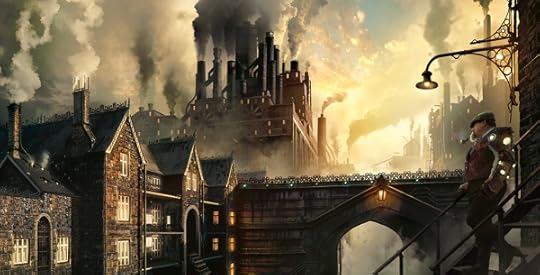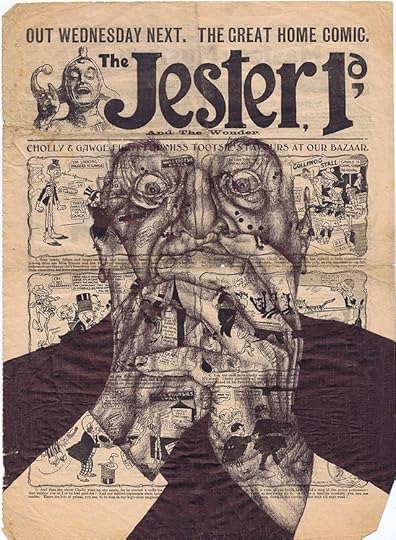Andrew Leon Hudson's Blog, page 7
May 19, 2014
Countdown: Four…
This is the week that was - the last week I wasn’t a novelist! But before I wave goodbye to the life I lived before…
The Darkside Codex has a large body of “canon” characters for the visiting writers to use as they see fit – providing they don’t spoil the fun for whoever follows them, that is. However, every writer is free to create their own inhabitants of Southwatch, and those we can treat as well or as badly as we might want!
So, I’d like to introduce the three main characters that I’ll be tormenting in the pages of The Glass Sealing: Arthur Marlen Singleton, Jocelyn Melody Duville, and Ben Shay.

Not necessarily how I imagined they’d look, but they look the part all the same!
Arthur Marlen Singleton
Sole child of hard-working, middle class parents, Arthur Singleton was a talented student and secured a place at one of Southwatch’s fine universities to study engineering – but he never forgot his origins and took to his studies with a serious dedication his mother and father would have approved of. Tall and pale beneath dark, dishevelled hair, he stood out in the corridors of learning and was similarly marked as a rising star in academia. He completed his degree and immediately joined the faculty, content to teach the odd class, grade student papers and pursue his own interests – which is to say, putting his skills into practical effect.
And doing exactly that threatens to lift Singleton out of dusty obscurity and into the big time, when his work catches the eye of Martin Duville, the moderately wealthy owner of unique transportation company. He is given a chance to break from his past (and the easy safety of university life) and prove himself in the real world. However, in the real world the rich sit on top of the pile and everyone else does a hard day’s work below them. A wise man would bear that in mind before he goes opening his mouth…
Jocelyn Melody Duville
A diminutive figure with striking rather than beautiful features, Jocelyn Duville is high society by birth but a businesswoman at heart - and she refuses to conform to the expectations of her class, at least regarding her gender. Heiress to the Duville transportation “empire”, a paltry fleet of reconfigured airships considered by its more conventional rivals as ill-suited to their new purpose, Jocelyn’s keen mind for business transforms the company’s fortunes. Suddenly her inheritance looks like a fine dowry, but Jocelyn subtly deflects any potential marital entanglements in favour of conducting romance on her own terms – much as she does in business.
Jocelyn’s success derives from a willingness to think creatively, to challenge the status quo; but when a certain Mr. Singleton encourages her to consider the subject of workers’ rights, he inadvertently exposes her to an uglier side of the lower classes and she is finally driven onto a more traditional path, putting such nonsense behind her. Then Jocelyn receives an offer she can’t refuse. It seems not all her privileged peers are so eager to merely toe the social line: a small number work in secret to champion the interests of Southwatch, even against the will of the city’s officials. They invite Jocelyn to join them, gifting her the opportunity to achieve more than she ever could alone – but her proposal in return is beyond even their expectations…
Ben Shay
Ben was born an impoverished Bricktowner and learned to blend into the background to avoid childhood beatings, first from his father and then from his fellow slum-dogs. He grew up to be the perfect informant for one of Southwatch’s street gangs, flawlessly melting into crowds and reporting back on everything he heard – eavesdropping on disgruntled factory workers, for example, so his intimidating boss can send a pack of strike-breakers in timely fashion. Being unobtrusive isn’t his only skill, mind, though it’s the only one he shares with his employer. He also has a handy knack for finding hard-to-spot things, a useful trick he keeps under his hat.
Now in his late-twenties, Ben is an average-looking type who rarely stands out and gets noticed, provided he keeps to the right kind of environment. This habit is compromised when he is given an unusual new assignment: instead of keeping a low profile, and one ear to the ground, Ben is to babysit a person of interest – an engineer with dubious notions of social equality. And because Ben knows what’s good for himself he does what he’s told, even though he can’t imagine what the leader of a street gang might want with some toff who calls himself “Arthur Marlen”…
-o-
There’s plenty more where they came from… and I hope that whets your appetite, because The Glass Sealing will be available to read at the end of this week!


May 16, 2014
Countdown: Five…
It’s just one week until The Glass Sealing is published - but before that happens, I want to introduce you to the world I was allowed to play around in.
The Darkside Codex is a shared world project: that is to say, the details of the world were created independently of any particular story, with the intention of allowing various writers to contribute to an ever increasing corpus of fantastical fiction. In the past there have been some notable shared world projects – Bordertown, Thieves’ World and The Fleet are the ones that most get mentioned – the hope is this one will be too.
So, without further ado:
Welcome to Southwatch!
Imagine a city of high towers, built over the ancient ruins of its predecessor. At its heart a huge steamworks provides power to the entire city, and a vast network of tunnels, sewers, caverns and more provide a home for myriad creatures that prefer to avoid the sun. But the sun doesn’t reach far in Southwatch.
The upper reaches of the city go by the name of the Aerie, and the Aerie shines in the daylight. Between the tower peaks glide dirigibles constructed of the unique alloy Bessem, glowing like jewels and home to only the wealthiest of citizens. In their midst two stand out: the Caelimane Temple, an enormous vessel housing thousands of priests devoted to the sun goddess Dione, and the airship-palace of the baron, absolute ruler of the city – though which of these truly wields most influence is a matter of opinion.
Aerial walkways, cable-cars and gyrocopters provide less elaborate means of getting around the heights of the city, and in the Aerie proximity to the baron’s airship reflects the prestige of the city’s most important families, but in Southwatch there is a more general indicator of significance: altitude. As one descends towards the streets far below, one’s position in the social hierarchy also falls. The gradient between the upper classes and the lower may be a subtle one, but one dividing line is not: the Dark Cloud, a free-floating mess of toxic smog that mars the city’s image like a cancerous shadow on an X-ray. This is the real city of Southwatch.
At ground level, the streets are bustling with steam- and clockwork-powered vehicles and, amongst the thronging pedestrians, primitive robots and other automatons hurry on the business of their owners. Here, Southwatch’s beauty is nowhere to be seen. In the Aerie the sun shines freely. Below the Dark Cloud, the city endures perpetual twilight, and the air is so fouled by deposits from above that the darksiders – as they are known – must wear breathing apparatus at all times if they are to have any hope of leading a long and fruitful life. But there are other threats to a person’s health than just going outside without a working mask.
Southwatch is a city of intrigues. From the financial district of Downtown to the docks and the Bricktown slums, there are a thousand ways to put a foot wrong and find yourself out of your depth. Gangs struggle for territory, politicians and businessmen vie for power and profits, and the ordinary people do what they are told to, if they have any common sense. And bubbling away beneath everything else is the Underground, that half-mapped warren where visitors should take great care they don’t attract the attention of other, perhaps less human, dangers…
However, this is also a place of endless potential. Salesmen and innovators ply their wares, inventors and scientists push back the boundaries of what is known, and artisans, artists and performers can always find an audience – maybe even a wealthy patron. Whatever else they might think or fear, the people of Southwatch know one thing for sure: they live in the most interesting city in the empire, bar none.
And it’s good when life is interesting. Isn’t it?
My gratitude goes to Ruslan Grebeshkov (Руслан Гребешков) for licensing that great steampunky image through Creative Commons. Click on the picture (or follow this link) and you can see just how skilled this piece of compositing is.


May 13, 2014
Countdown: Six…
I just spent a whole lot of time waxing extensive about cover art in fantasy and scifi, the reason being that I wanted to explain why my book has the cover it has – and then I realised:
Shut up and show the cover, idiot!
Hope you like it!
Now that’s out of the way, here’s that essay I mentioned.
A lot of genre fiction ends up hiding behind certain kinds of image and, though I’d like to claim that I’m a science fiction writer, it’s probably true to say that Steampunk is as much fantasy as it is scifi.
The popular choice for fantasy covers (at the moment, in my opinion) tends to include a strikingly heroic figure before some strikingly striking background, often making strong eye-contact with the prospective reader while wielding a sword, or a gun and a sword, or (if female) touching a dragon, or (if male) dropping into sight like the assassin hero of some popular computer game franchise… you may know the one I mean.
Scifi can do all of that too, apart from the dragon, probably, but in place of that we have lots of dystopian fiction, so we get to see the hero/ine(s) viewed from behind as s/t/he(y) nobly survey some crumbling wasteland… All that’s fine, of course, and this is more or less the way the other covers in the Darkside Codex have gone so far; but my heroes aren’t the dragon-touching, sword-and-gun-wielding type. Eyebrow pencil or screwdriver wielding is more their normal pace. I wanted something different.
However, scifi also has another option in its cover art arsenal: the Symbol. In recent years there have been the three bird emblems from The Hunger Games, and other YA titles have used some iconic visual hook to good effect, but there is a fine old tradition in the genre - Alan Moore gave us two, one in Watchmen‘s adoption of the smiley-face pin, another in the anarchy-inspired graffiti of V for Vendetta - and the Circle-A was at the front of my mind when Kelly Shorten, Musa Publishing‘s Art Director, asked what I wanted for my cover art.
My story features a little bit of social unrest – it was partly inspired by Occupy Wall Street, as filtered through the dusty lens of England’s Industrial Revolution. Enter the Workers’ Movement, an illegal meta-union of disillusioned, dispossessed and displeased labourers who decide they will no longer stand by while the idle rich lord it over them. And, like any good anarchists, they leave their mark in the wake of their protests…

In the text I describe it as “two vertical chevrons crossed in a rough-painted circle, to form the letters W over M” – but I always worried that my description wouldn’t convey to the reader what I meant. The cover art was my chance to make it crystal clear: it might not be glamorous, but a grey brick wall with my symbol painted on it would also paint a thousand words (and, conveniently, it also colour matched the branding on the lower half of the cover, which all the Darkside Codex books must carry).
The final version is pretty close to what I imagined. Kelly put up with my repeated suggestions far longer than she need have, but given the chance I’d still be asking for tweaks come publishing day. In the end I bit my tongue, said “that one”, and we were both free to get on with our lives.
So, my thanks to Kelly for her work – now I just have to wait and see how it looks on my Kindle!


May 10, 2014
Countdown: Seven…
They say (“they” being writers, or anyone who has an opinion on the subject of being one, half-way informed or not) that there are certain benchmarks to be reached that indicate just how much of a Real Live Writer you truly are.
Writing Every Day is one of them.
Being Published (according to what other people consider that to mean) is another.
Being Rejected For Being Published is too.
Hopefully those aren’t a cumulative requirement, because at the moment I probably score about one-and-a-half out of three, and the one is in the rejection column. There are probably a whole lot of other criteria that I don’t qualify for either, but I don’t want to rain too much shit on myself so let’s draw a line under that for now.
Anyway, regardless of how seriously one might be taken as a writer, there are also considered to be certain benchmarks that indicate how close to finished a novel is. Writing The End on a page isn’t the last one, not by a long shot. For just under two months I’ve been “officially” editing the manuscript I submitted last October, and I’ve lost count of the number of times I’ve read my own story in that time.
First came the content editing. We did three full passes over the text, adding in here, taking out there–we discovered a gigantic no-no with one week to go (I’d contravened cardinal story-world rules) and had to scramble for a fix at the very last minute (found one!). It’s work, sure, but it’s still fun because it’s as much writing as anything else.
Next came line editing, and that’s a different kettle of fish altogether. Whereas the content editor was looking at the story, the line editor targeted mistakes and inconsistencies in grammar, formatting, all that good stuff. Instead of the larks of the previous weeks, now I had to read the whole thing line by line, comma by comma, to ensure I hadn’t secretly torn any pages out of the Chicago Manual of Style.
So I did.
A week ago I’d made the required changes, challenged the edits I didn’t agree with and sent it back for the line editor to review. She processed the changes and sent it back so I could read it all over again.
So I did.
And all was good! The manuscript was okayed and sent on to be transformed into the final version, ready for consumption. All that left was… the copy edit. One more pass before it goes to “press”, to make sure that nothing slipped through all the other times.
So I will.
But I have to say, after all that reading of my beloved story, I hate that thing now. Just the notion of going over it one more time makes my stomach turn and my skin crawl.
And THAT is how you know your novel is almost finished.
Either that, or you blink and discover the manuscript lying on the floor in a pool of lighter fluid, a lit match in your shaking hand… thank god for ebooks, eh?

Substitute a lap top for that printer and you’ve just about got the way I now feel about flipping the screen up and reading my god-damned novel one more time.


May 1, 2014
Countdown: Eight…
April 17, 2014
The Lord of Misrule
A brief digression: I entered a little on-line contest in March…
…and didn’t win.
Ah well, what was my loss I will now attempt to make your gain, by presenting failure as entertainment. Five verses, iambic octameter (that means “sixteen syllables per line”, read it duh-duh, duh-duh, duh-duh, duh-duh… if you want to).
So. Here, have a rhyme.
The Lord of Misrule
They call the leader of the proud King’s entertainers “Prince of Fools”.
All year he pranks, and jokes, and sings; in nonsense rhyme evinces rules
And regal edicts, tumbling as courtiers mock–and all the while
His majesty laughs on, the bitter bumbling jester wears a smile.
Then when the year comes to a close, that season northerners call Yule,
The king, in action grandiose, names his pet man Lord of Misrule,
And freely gives all symbols of command to this ennobled clown–
But, as he abdicates the throne, he sees no grin beneath the crown.
With bells and costume cast aside, the buffoon makes himself a ghoul
Of retribution for their snide mistreatment. He gives leave for cruel
Fun and much merry-made abuse, his orders prompting howls and squirms:
The King an ass! The priest a whipping boy! The rich crawling like worms!
Then at his signal–as the King crawls, as the courtiers all drool
And fight each other for their turn to ride upon the royal mule–
The entertainers raise the gates, throw all doors wide, let in the world,
And as disorder reigns the banner of new order is unfurled.
This low court desecrates the high and, as his master’s body cools,
The jester contemplates his prize, the crown of gold and precious jewels.
Amidst the corpses, poor folk dance and reel and splash through bloody pools.
Come dawn, the wisest amongst them will kneel and hail him King.
Of fools.


April 14, 2014
At the Hop – the blog-hop, that is…
I was recently tagged in a blog hop by N. E. White, fantasy writer and editor of the anthology I had a story in last year (so I guess that means I now owe her two). After googling “blog hop” to make sure I knew what was happening to me–which I did, thank you very much–I was happy to be involved.
The subject of this pseudo-chain-letter is “questions about your writing process”, which for authors is a bit like approaching someone at a party and saying “So, tell me all about your job”. I’ll totally understand if I’m now talking to myself. Just let me put some music on in the background… okay, let’s go to the hop:
1) What are you currently working on?
Apart from novel editing (see most of my recent posts), I’m alternating between planning a sort of sequel and hovering my mouse over the folder containing a previous Work In Progress – a scifi/fantasy novel I’d really like to get finished. I usually keep something smaller handy as a palate cleanser, and at the moment that’s a submission to a follow up anthology, this time an Alternate History collection focusing on World War One. That deadline is creeping up though.
2) How does your work differ from others in the genre?
My current novel is Steampunk and in the first draft I attempted the genre’s default stylistic approach, which is to say I tried to fake a period tone by using slightly over-elaborate vocabulary and sentences. However that isn’t a Steampunk universal, and in general I think my writing has developed a “voice” that is my own (not that I’m making any grand claims there: I just write the way I do). So, if I bring anything unique to the genre I guess it’s that. Aside from a kick-ass story the likes of which have never been seen before, of course.
3) Why do you write what you write?
I’ve always been an enthusiastic reader of scifi and horror, perhaps less so of the latter as I’ve aged, but to an extent they are still the genres that drive me. In the specific case of The Glass Sealing, though, I was partly inspired by the legacy of the Occupy Wall Street movement, which played out more or less on my doorstep here in Madrid.

The occupation of El Plaza del Sol, 2011. Click the pic for more info.
Starting in 2011, a square in the heart of the city played home to a tent camp for months on end as people protested the Spanish government’s response to the global financial crisis. It was only fully cleared ahead of the Pope’s World Youth Day visit a year later (both at once would have been too much contention to bare…). Though mostly it was a peaceful protest–and a peaceful containment–aggressive tactics were used at times and I put some of that into my story. You could call mine a Luddite version of Occupy Wall Street set during an imaginary Industrial Revolution. Steam-powered Robots Won’t Take Our Jobs!
4) How does your process work?
I’d have to say… Occasionally. In 2013 I was scarily productive, churning out a quarter of a million words (about four times my previous record). This year it’s been far, far less. I have excuses, but they don’t deserve to be aired.
I vary in my approach: I’m mostly a planner on big projects, mostly a seat-of-the-pantser on short fiction–but in both cases I tend to spend a lot of time thinking before I get started. When I’m in the right mode then the words flow and I’ll clear a thousand in no time. When they don’t, I’ll be lucky to manage a hundred all day. In any other line of work, I’d get fired.
Okay, that’s my answers, hope I found them interesting. And in the interest of broadening the horizons of any hypothetical readers that made it this far, here are a trio of friendly writers to whom I pass on the baton:
Sean McLachlan | Nicola Jane | Lance Tooks
Postscript: another friendly writer, Tony OG, is very unhappy that I didn’t point people his way too. So now I have. He doesn’t usually blog about writing, but he is quite talented so maybe we’ll all be lucky and he’ll start.
Post-postscript: everyone else who knows me can go hang–what am I, a charity?
Post-post-postscript: gowan, get– getoutofhere! Leave me alone!
Post-post-post-postscript: stop looking for things that aren’t there. Like my generosity.


April 9, 2014
Countdown: Nine…
A week ago I finished the first edit of my novel and slotted it into Musa Publishing‘s internal document wrangling device. Then, exhausted and perspiring, I collapsed into a corner like a punch-drunk prize-fighter to desperately recover some energy in the brief respite before the second round.
Of course, I exaggerate. Editing actually proved a largely painless process, and I had no doubts that the manuscript was better as a result. The job was still unfinished–the questions I asked needed answering before I could continue, and any changes I had made needed to be vetted before they could be accepted–but all things considered the situation seemed rosy. The Glass Sealing was in good shape, and in a fit of unexpected motivation I even managed to carry my work ethic over into other projects.
Everything was going so well.
And then came…
Rampant Imperialism.
My editor broke the news: the powers that be had decided that, rather than fostering an atmosphere of transatlantic equality amongst their authors, the Darkside Codex was to use (I can hardly bring myself to type the words) American English Only.
Naturally, I lodged a vigorously worded letter of protest on the spot. I was cursorily informed that Musa Publishing proclaimed the incomprehensible right to defend the use of American English even outside the borders of America. I barely had time to reel from this shocking act of international injustice before I received the document with the editor’s second edits.
Never before have I seen so many Z’s. Never before has a chaise longue been a chaise lounge. Never before has the word “colour” looked so drab. Even with a wiggly red line beneath it.
No hyphen in my no-one.
Really, I don’t know if I can continue. I never thought I’d say it, but I may have to go back into English Teaching… British English.
LONG LIVE THE QUEEN!




March 24, 2014
First In, Last Out
Life gets boring without a visit to Mythaxis. For me at least.
When the editor got in touch I almost danced for joy. It had been a year since the last one.
I offered him a short story about the risks of working towards the relentless advance. I think he empathised.
Is that a hand at the edge? Is that a person?
Addendum: although I hope you read all the stories there, I especially recommend you read Liam Baldwin’s The Lost World of WW1 and Jez Patterson’s Aye-Nay–because both of them are lovely chaps and you’ll like their stories as much as you’d like them personally, if you don’t already.


March 14, 2014
Countdown: Ten…
About ten days ago, I received first contact from my editor (saying that feels absurdly nice: I have an Editor!), who introduced herself and let me know that she was already reading the novel–and enjoying it too. Though I imagine few working relationships begin with the words “Nice to meet you, you’re a talentless hack”, I have no reason to doubt her words, especially since she got in touch again to say she’d finished, she still liked it, and that it was time to begin…
The Editing Process.
…eek!
That email was the first tick of the countdown: if all goes well, just over two months from The Glass Sealing will be published (Andrew does a little dance). However, between now and then I will have to do a whole bunch of things I’ve never had to before–or rather, things no-one else has demanded I do. Little dances possibly included, I’ve no idea–but let’s hope not, as the only thing less well-coordinated than me on a dance floor is my disco suit (this being Steampunk, probably what I ought to say is my formal evening wear. Doesn’t matter, I don’t have anything good there either).
My partner for the coming waltz (she’ll be leading) is Damien Angelica Walters, a genre author in her own right, with the horror novel Ink and a variety of short fiction sales to her name. A project development editor at Musa Publishing, creators of this shared world project, she has also been given responsibility for editing all the novels in the Darkside Codex to ensure continuity between the various writers contributing to the series. Sounds like a good idea, so what does that mean for me?
I’ve now received the “editor’s first edits” of my manuscript. My next job is to review them and respond with the “writer’s first edits”. Damien’s feedback ranged from the relatively trivial (typos, spelling errors and punctuation conventions that I missed or just got wrong) through the more significant (notes on theme and content that will help integrate my novel with the series as a whole) to the potentially problematic (slips in the point of view, superfluous scenes, confusing passages… damn). In this first round my responses could simply be a series of dis/agree statements so we can discuss the pros and cons of what she’s raised; however, there’s not much I can honestly contest so I’ll be modifying the text at this stage as well.
Regardless, we’ll have this back-and-forth at least twice, followed by a meticulous line edit of the final galleys to sweep for overlooked mistakes. If anything slips through that net, I’ll have to live with it… but that said, my early impression of all this has been very positive and Damien has made sure these baby steps aren’t too intimidating. Of course, there’s more to come than “just” the editing–there’s cover art to develop and finalise, promotional strategies to put into action, breakdowns to recover from–but that’s enough procrastinating for today. I’ve got some reading and writing to do: full steam ahead…
Thanks to Alexander “Steampunker” Schlesier for the image!












